Writing an equation of a circle in standard form
Example: Write the equation of a circle in standard form.

Start by grouping the x terms together, grouping the y terms together and moving the constant to the other side of the equation.

Use completing the square on the group of x terms and the group of y terms.
To find the number that completes the square for the x group, start with the coefficient of the x term, half it and square it. The coefficient of the x term is 4

To find the number that completes the square for the y group, start with the coefficient of the y term, half it and square it. The coefficient of the y term is -8

Add these numbers to the group of x terms and the group of y terms. Be careful to maintain the balance of the equation by adding the numbers to both sides of the equation.


Now the group of x terms is a perfect square trinomial and will factor to be a binomial squared. The group of y terms will do the same.


The equation of the circle is written in standard form where it is easy to recognize the center and radius of the circle.
The center is (-2,4) and the radius is 9.
Finding the Intercepts of a Circle Touching an Axis (Tangent to an axis)
An x-intercept is where the graph touches or crosses the x-axis.
A y-intercept is where the graph touches of crosses the y-axis.
To find an x-intercept: Let y=0 and solve for x.
To find an y-intercept: Let x=0 and solve for y.
Example: Find the intercepts of the circle for the given equation.

Solution:
To find an x-intercept, let y=0 and solve for x.










This equation has one x-intercept. 
To find a y-intercept, let x=0 and solve for y.











Approximately  and
and 
This equation has two y-intercepts.  and
and 
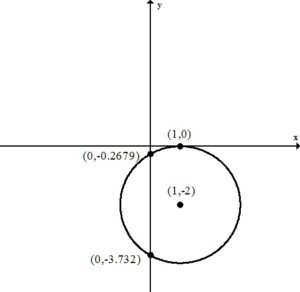
A tangent line to a circle may be defined as a line that intersects the circle in a single point.
This circle is tangent to the x-axis since it is touching the x-axis in a single point. The x-axis (y=0) is the tangent line for the point on the circle (1,0).
Example: Find the intercepts of the circle for the given equation.

Solution:
To find an x-intercept, let y=0 and solve for x.











Approximately  and
and 
This equation has two x-intercepts.  and
and 
To find a y-intercept, let x=0 and solve for y.










This equation has one y-intercept.  .
.

This circle is tangent to the y-axis since it is touching the y-axis in a single point. The y-axis (x=0) is the tangent line for the point on the circle (0,1).
Finding the Intercepts of a Circle (4 Intercepts)
An x-intercept is where the graph touches or crosses the x-axis.
A y-intercept is where the graph touches of crosses the y-axis.
To find an x-intercept: Let y=0 and solve for x.
To find an y-intercept: Let x=0 and solve for y.
Example: Find the intercepts of the circle for the given equation.

Solution:
To find an x-intercept, let y=0 and solve for x.











Approximately  and
and 
This equation has two x-intercepts.  and
and 
To find a y-intercept, let x=0 and solve for y.











Approximately  and
and 
This equation has two y-intercepts.  and
and 
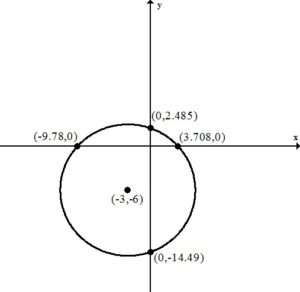
Finding the Intercepts of a Circle (center at the origin)
An x-intercept is where the graph touches or crosses the x-axis.
A y-intercept is where the graph touches of crosses the y-axis.
To find an x-intercept: Let y=0 and solve for x.
To find an y-intercept: Let x=0 and solve for y.
Example: Find the intercepts of the circle for the given equation.

Solution:
To find an x-intercept, let y=0 and solve for x.






This equation has two x-intercepts.  and
and 
To find a y-intercept, let x=0 and solve for y.






This equation has two y-intercepts.  and
and 
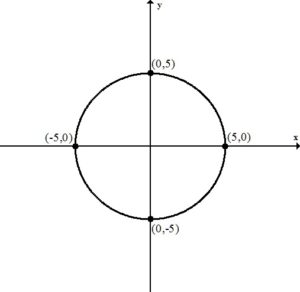
Write the Equation of a Circle Given the center and the radius
Example: Write the equation of a circle in standard form given the center of the circle is (5,7) and the radius of the circle is 6. Then write the equation in general (expanded) form.
Solution:
The standard form of an equation of a circle is  where r is the radius and
where r is the radius and  is the center.
is the center.
The center of our circle is  . So
. So  and
and  .
.
The radius of our circle is 6 so  .
.
Replace h, k and r in standard form of an equation of a circle.

Simplify.

The equation of a circle in standard for with center (5,7) and a radius of 6 is  .
.
To write the equation in general form we can start with the standard form we just found and multiply each binomial.







The equation of a circle in general form with center (5,7) and a radius of 6 is  .
.
Find the center and the radius from the equation
A circle is the collection of points that are equidistant to a center point. The distance is the radius denoted r. The center is denoted  .
.

The standard form of an equation of a circle is  where r is the radius and
where r is the radius and  is the center.
is the center.
Example: Find the center and the radius from the given equation.

Solution: If you line up the standard form of a circle with the equation given you can determine the center and the radius.
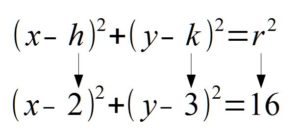
In the binomial with x, the number after the minus sign is h. Thus,  . In the binomial with y, the number after the minus sign is k. Thus,
. In the binomial with y, the number after the minus sign is k. Thus,  . The
. The  lines up with 16. So
lines up with 16. So  which means
which means  .
.
This is the equation of a circle with a center of  and a radius of
and a radius of  .
.
Example: Find the center and the radius from the given equation.

Solution: Notice that one of the binomials has a + instead of the – that is in the standard form of the circle. Rewrite the addition as subtraction.
 is the same as
is the same as  .
.
The rewritten equation is as follows.

Then, if you line up the standard form of a circle with the equation given you can determine the center and the radius.
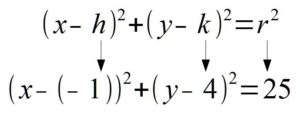
In the binomial with x, the number after the minus sign is h. Thus,  . In the binomial with y, the number after the minus sign is k. Thus,
. In the binomial with y, the number after the minus sign is k. Thus,  . The
. The  lines up with 25. So
lines up with 25. So  which means
which means  .
.
This is the equation of a circle with a center of  and a radius of
and a radius of  .
.
Example: Find the center and the radius from the given equation.

Solution: Notice that one of the binomials has a + instead of the – that is in the standard form of the circle. Rewrite the addition as subtraction.
 is the same as
is the same as  .
.
The other binomial doesn’t have any number added or subtracted. We can rewrite this by subtracting zero.
 is the same as
is the same as  .
.
The rewritten equation is as follows.

Then, if you line up the standard form of a circle with the equation given you can determine the center and the radius.
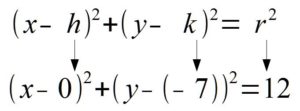
In the binomial with x, the number after the minus sign is h. Thus,  . In the binomial with y, the number after the minus sign is k. Thus,
. In the binomial with y, the number after the minus sign is k. Thus,  . The
. The  lines up with 25. So
lines up with 25. So  which means
which means  .
.
This is the equation of a circle with a center of  and a radius of
and a radius of  .
.
Graphing an Absolute Value Equation Shifted Horizontally by Plotting Points
Plotting Points Method
- Find ordered pair solutions
- Choose values for one variable
- Find the value for the other variable
- Plot the ordered pair solutions
- Draw the line or curve that connects the ordered pairs
Example: Graph  by the plotting points method.
by the plotting points method.
1. Find ordered pair solutions. We can organize this information in a table.
- Choose values for one variable
When the equation is written in “y=” format it is easier to choose values for x and then find the y’s. Although you are allowed to choose any x values, for this table I have used a standard set of x’s so that we have a variety. Some negatives, some positives and zeros.
- Find the values for the other variable
To find the y’s substitute the value of x into the equation and simplify to find y.
2. Plot the ordered pair solutions
Using the table above we have 5 ordered pairs 
Plot the ordered pairs using the rectangular coordinate system.
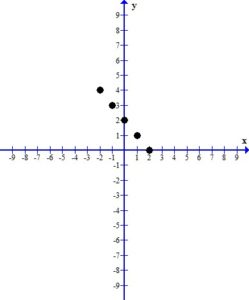
3. Draw the line or curve that connects the ordered pairs.
When you look at the plotted ordered pairs you should see a pattern the that points make. As I discussed in a previous post, most absolute value graphs form a “v” shape. It seems I am not graphing the portion of the graph that shows the “v” shape. With the plotting points method all I can do is find more ordered pairs to try to get the correct graph. However, in a future post, we will discuss other graphing methods give us more information about where the interesting part of the graph is.
In the mean time, to finish this graph I need just one more ordered pair.  which I get from plugging three into the equation for x.
which I get from plugging three into the equation for x.
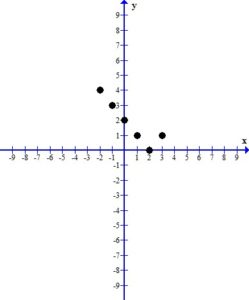
This makes the graph have the “v” shape we expected.
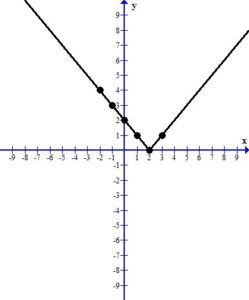
The line represents all of the ordered pairs that are solutions to the equation  .
.
Graphing an Absolute Value Equation by Plotting Points
Plotting Points Method
- Find ordered pair solutions
- Choose values for one variable
- Find the value for the other variable
- Plot the ordered pair solutions
- Draw the line or curve that connects the ordered pairs
Example: Graph  by the plotting points method.
by the plotting points method.
1. Find ordered pair solutions. We can organize this information in a table.
- Choose values for one variable
When the equation is written in “y=” format it is easier to choose values for x and then find the y’s. Although you are allowed to choose any x values, for this table I have used a standard set of x’s so that we have a variety. Some negatives, some positives and zeros.
- Find the values for the other variable
To find the y’s substitute the value of x into the equation and simplify to find y.
2. Plot the ordered pair solutions
Using the table above we have 5 ordered pairs 
Plot the ordered pairs using the rectangular coordinate system.
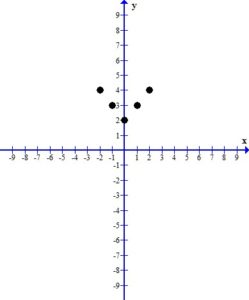
3. Draw the line or curve that connects the ordered pairs.
When you look at the plotted ordered pairs you should see a pattern the that points make. In this case, the points form a “v” shaped graph. Most of the equations with absolute value have graphs of this shape.

The line represents all of the ordered pairs that are solutions to the equation  .
.
Graphing a Quadratic Equation by Plotting Points
Plotting Points Method
- Find ordered pair solutions
- Choose values for one variable
- Find the value for the other variable
- Plot the ordered pair solutions
- Draw the line or curve that connects the ordered pairs
Example: Graph  by the plotting points method.
by the plotting points method.
1. Find ordered pair solutions. We can organize this information in a table.
- Choose values for one variable
When the equation is written in “y=” format it is easier to choose values for x and then find the y’s. Although you are allowed to choose any x values, for this table I have used a standard set of x’s so that we have a variety. Some negatives, some positives and zeros.
- Find the values for the other variable
To find the y’s substitute the value of x into the equation and simplify to find y.
2. Plot the ordered pair solutions
Using the table above we have 5 ordered pairs 
Plot the ordered pairs using the rectangular coordinate system.
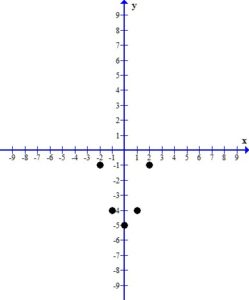
3. Draw the line or curve that connects the ordered pairs.
When you look at the plotted ordered pairs you should see a pattern the that points make. In this case, the points form a “u” shaped curve called a parabola. Most of the equations with x squared have graphs of this shape.

The line represents all of the ordered pairs that are solutions to the equation  .
.
Here is a youtube video with a similar example.